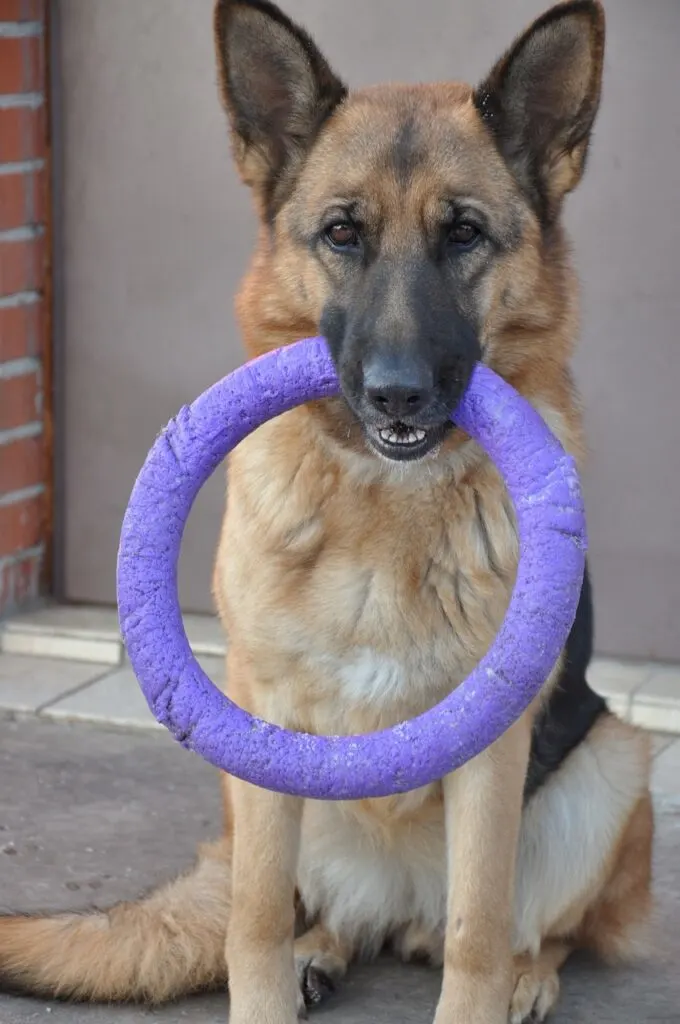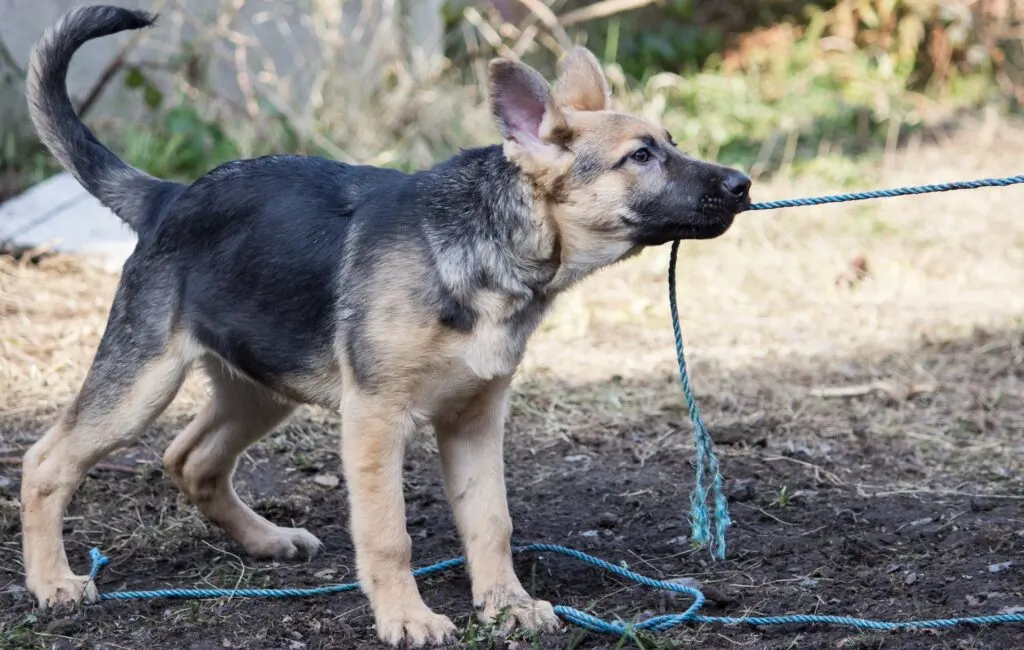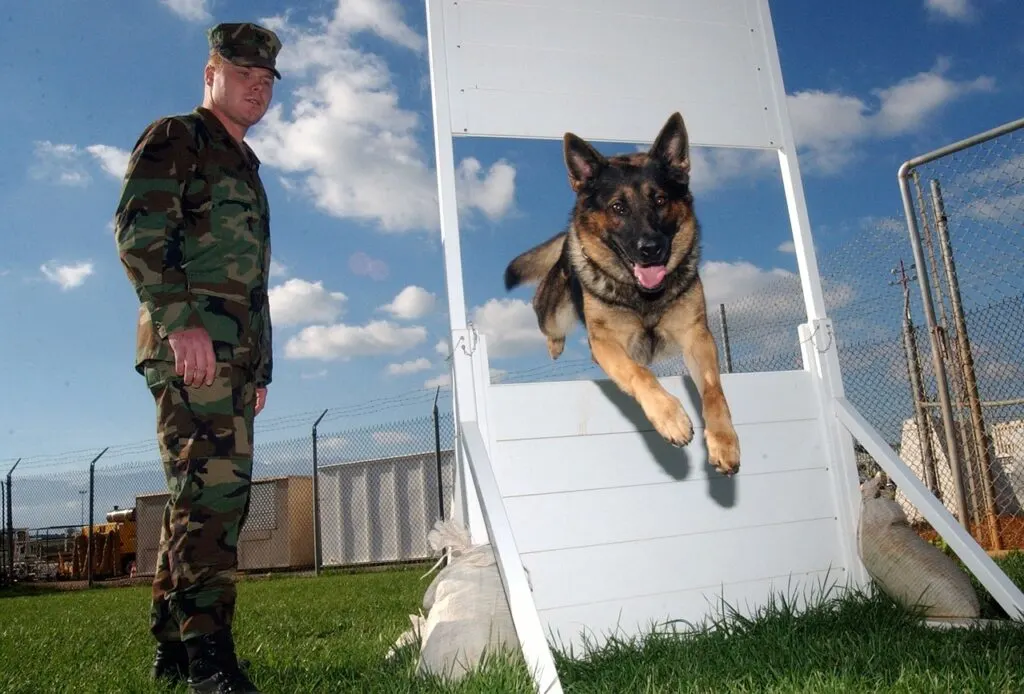Exercise Needs of Large Dog Breeds
If you’re a proud owner of a majestic canine companion like a German Shepherd, you know they are bundles of energy. These dogs love to stay active, running around the yard with unmatched enthusiasm.
In fact, they need physical activity more than you might think. These larger-than-life dogs have unique exercise requirements, which can reduce their quality of life if they aren’t met.
This article explores the importance of daily exercise for giant breed dogs and the specific activities they benefit from. It also explains how to strike the perfect balance between keeping them fit and happy.
Here’s how to keep our big furry buddies healthy through dog exercises.
Key Takeaways
- Large dog breeds need ample exercise to lead happy and healthy lives.
- A mix of both indoor and outdoor exercises is beneficial. Outdoor activities provide opportunities for exploration and interaction with the environment, while indoor exercises offer safe and enjoyable alternatives during unfavorable weather conditions.
- The amount of movement required for large dogs can vary based on individual factors, such as breed traits, age, and energy levels.
Why Is Exercise Important for Large Dog Breeds?

Large dogs require a lot of high-impact exercise to live a happy and healthy life.
As a general rule, they need at least 2 hours of exercise per day. Therefore, it’s crucial to ensure your dog is getting enough physical and mental stimulation every day.
Here’s a list of benefits physical activity provides for dogs.
Improved Health
Regular exercise is crucial for maintaining the physical health of large dog breeds. Getting enough exercise strengthens their muscles, keeps their weight in check, and promotes cardiovascular fitness and overall stamina. It also increases joint mobility and can reduce the risk of certain health conditions, such as hip dysplasia and arthritis.
Mental Stimulation
Large-breed dogs are intelligent and require mental stimulation to prevent boredom and destructive behaviors. Running around or playing tug of war engages their minds, keeps them mentally sharp, and helps prevent behavioral issues caused by excess energy. Activities like fetch or puzzle games are perfect for giving your dog enough exercise for their mind.
Prevention of Obesity
Obesity is a common problem in large dog breeds, and it can lead to a variety of health issues. Regular exercise helps burn calories and maintain a healthy weight, reducing the risk of obesity-related conditions like diabetes, heart disease, and joint problems.
How Much Exercise Does a Large Dog Breed Need?
The exercise needs of large dog breeds vary.
Breeds such as the Chow Chow, Mastiff, and Saint Bernard only need about an hour of exercise daily. On the contrary, German Shepherds and male Belgian Malinois require two hours or more of exercise and mental stimulation.
To determine if your dog gets enough movement, you should take into account its age and energy levels, among other factors.
Here are the critical aspects to consider.
Differences Between Breeds
As mentioned above, different large dog breeds have different exercise requirements.
Big dogs like the Bernese Mountain Dogs and German Shepherds are highly active and energetic. Thus, they require more exercise compared to small dogs.
Conversely, small dog breeds like the Bulldog or Shih Tzu are more laid-back and require moderate exercise.
Age and Energy Levels
Dogs’ exercise needs also change as they age.
- Puppies have higher energy levels and require more frequent exercise sessions but in shorter durations.
- Adult dogs need regular exercise to maintain their health and fitness.
- Older dogs may have reduced exercise needs but still require gentle activity to keep their joints mobile and muscles toned.
General Guidelines for Exercise Duration
Large or giant breed pups need at least 5 minutes of exercise for every month of their age.
Large and giant dog breed adult dogs, on the other hand, should have at least 30 minutes to 2 hours of moderate to vigorous exercise daily. This exercise routine can be divided into multiple sessions throughout the day.
Nevertheless, it’s essential to adjust the duration and intensity of training based on your dog’s age, breed, and individual needs.
What Are Some Ways to Exercise a Large Breed Dog?
Every dog owner can use numerous ways to get their dog moving.
Whether big or small, all dogs need exercise. Here are some popular options for providing the physical and mental stimulation they need:
Regular Walks or Jogs
Taking your dog for a walk or a jog is a fundamental form of exercise. It allows them to explore their surroundings, meet other friendly dogs, and stay in good shape. The length and pace of the activity can vary based on your dog’s abilities and fitness level.
Off-Leash Play in a Dog Park
Local dog parks provide an ideal opportunity for large breeds to socialize and burn off excess energy. Off-leash play allows them to run, explore, and interact with other dogs in a safe and controlled environment.
Playing a Game of Fetch
Playing fetch is an excellent way to engage your large breed dog’s mind and body. They can chase after the ball, return it to you, and repeat the process. It’s a fun and interactive game that helps to build their muscles and keeps them mentally stimulated.
Hiking
Large dog breeds can greatly benefit from the challenges and joys of hiking alongside their human companions. The varied terrain and natural scents provide mental enrichment, while the physical demands of hiking keep their muscles strong and their weight in check.
Remember, it’s crucial to “take it easy” at the beginning and gradually increase the intensity and duration of hikes to match your pet’s fitness level.
Finding Hidden Objects
Every dog, with their keen sense of smell and natural curiosity, loves this activity.
The thrill of using their noses to track down hidden treasures or scents provides dogs with mental stimulation and a sense of accomplishment. Incorporating dog treats into the activity can also make the exercise more enticing for your four-legged friend.
Swimming
In contrast to cats, swimming is a refreshing exercise that many dogs enjoy. For large dog breeds, in particular, it offers a low-impact, full-body workout that is gentle on their joints.
Whether it’s splashing in a pool, playing in a lake, or frolicking at the beach, this exercise allows them to move freely and engage their muscles without putting too much strain on their bodies.
Doggy Playdates
Many dogs enjoy the opportunity to play with other family dogs, engaging in games of chase, wrestling, and friendly tussles. These playdates not only provide much-needed physical activity but also offer valuable socialization opportunities.
Playing Tag
This famous dog sport provides a fantastic way to burn off energy and engage in physical activity. When you play tag with your dog, you help it stay in shape while strengthening your bond through play. This dynamic activity is enjoyable for everyone involved and serves as a form of mental stimulation for your furry friend, keeping their minds sharp and alert.
Indoor Exercise Ideas for Large Dogs

Dogs living in apartments often fall victim to a lack of exercise. Without free access to outdoor spaces, they’re stuck in a room with just four walls and absolutely nothing that could satisfy their activity cravings.
But there are some things you can do to keep your canine companion the physical activity it needs.
Here are some indoor exercise ideas to keep your large dog active and entertained.
Indoor Agility Exercises
First of all, you could set up an obstacle course using chairs, blankets, and tunnels. Teaching your dog to navigate through the course, jump over hurdles, crawl under obstacles, and weave through poles can be a fun challenge.
Agility exercises help to improve coordination, balance, and overall fitness.
Indoor Dog Park
Indoor dog parks present a fantastic alternative to exercise your dog, especially during days when outdoor activities may not be feasible. They are designed to keep your furry companion engaged and active. Your dog will be thrilled to test their agility courses, exciting obstacles, and play platforms.
Some indoor dog parks even offer convenient monthly memberships for pet owners seeking a regular exercise routine for their dogs.
Tug of War Playtime
Tug of War is a great way to engage in interactive play with your dog indoors. It is an excellent physical activity for dogs with surplus energy to burn off.
Simply use a sturdy rope or toy and let your dog tug on it while you provide gentle resistance. This game will satisfy your dog’s natural instinct to pull and tug while strengthening its muscles.
Interactive Puzzle Toys
Interactive puzzle toys are designed to mentally challenge and stimulate dogs. Fill the toys with treats or kibble, and let your dog figure out how to get the rewards.
It’s a creative way to provide your four-legged friend with mental stimulation. Thanks to it, you can keep your dog occupied and entertained for many hours.
What Are the Exercise Requirements for Large-Breed Puppies?
Large-breed puppies have specific exercise needs. Meeting these requirements is vital to their growth and maintaining good health.
Nonetheless, the regimen should be appropriate to their size. They need to spend their energy without putting undue stress on their still-growing bones and joints.
A well-exercised puppy is likely to be healthier, well-behaved, and happier. But creating too strict of a training routine can quickly backfire if you’re not careful.
Here are some fundamental points to consider:
Understanding Large Breed Dog Growth Development
Large and giant breeds of dogs, despite a shorter average lifespan than smaller breeds, need a longer time to fully develop. The younger the puppy is, the less exercise time it should have.
Don’t mistake a pup’s enthusiasm as a sign they can exercise for long periods. Large breed dogs only complete their growth at about 15 months old. Until then, their full energy potential isn’t developed.
Puppy-Safe Exercise Activities
Protecting your pup’s developing joints from rigorous activities is vital. Long hikes or agility training may be too intense at an early age. Ensure the exercises are gentle until your dog’s joints are fully developed.
Activities like short walks, controlled play sessions, and swimming are your best option. They promote muscle development, coordination, and socialization without causing excessive stress on your dog’s growing body.
When it comes to rest, let your puppy nap as much as they want. A bit of exercise can easily tire them out, and plenty of rest is essential for proper growth and development.
Training for Obedience and Exercise
Training sessions for obedience and basic commands can also double as an exercise for large-breed puppies. Incorporating training exercises during playtime helps to engage their minds, improve their behavior, and provide the necessary exercise they need.
Here are some training tips you can try when training your adorable large breed pups:
Working Dogs: Extra Exercise Needs

Working breeds like the Border Collie, German Shepherd, and Labrador Retriever have additional exercise needs due to their high energy and drive. These breeds require physical exercise and mental stimulation through training and job-related activities.
Understanding the Specific Needs of Working Breeds
Working breeds have varying levels of activity. They might not be as active as pastoral or gundog breeds, which are bred for constant, daily activity. Yet, they certainly can’t be labeled as inactive.
These dogs have a strong work drive and need ample exercise to keep them happy and fulfilled. Lack of physical and mental stimulation can lead to behavioral issues, anxiety, and destructive behaviors.
Providing Mental Stimulation Through Training
Working breeds thrive on mental challenges. Training sessions that include learning new commands, problem-solving tasks, and obedience exercises can stimulate their minds and provide the mental exercise they require.
While many working breeds are independent thinkers and often have their own agenda, some make excellent service dogs, especially in the armed forces. The combination of their intelligence and strength makes them ideally suited for this kind of work.
Incorporating Job-Related Activities Into Exercise
Working dog breeds grow into large, powerful dogs. As a result, they require training for safety and sociability.
With the proper training and respectful handling, these dogs can be incredibly rewarding and devoted companions. However, without adequate training, they may pose a risk to others and themselves.
Working breeds excel at job-related activities such as herding, retrieving, or scent detection. Incorporating these activities into their exercise routine allows them to indulge in their natural instincts and gives them a sense of purpose and fulfillment.
Final Thoughts
Large breed dogs need various forms of activity, making exercise a key aspect of their health and well-being. Regular training sessions provide numerous benefits for your furry friend, including improved physical health, mental stimulation, and prevention of obesity.
However, the amount of exercise needs to be adjusted based on individual breed traits, age, and health conditions. Large dogs with higher energy levels may need more vigorous activities, while older or less active breeds may benefit from gentler exercises.
Both outdoor and indoor exercises are crucial in fulfilling your dog’s exercise requirements. Outdoor activities allow large dogs to explore, run, and engage with nature. At the same time, indoor facilities like dog parks provide a safe and fun environment for exercise during inclement weather.



















